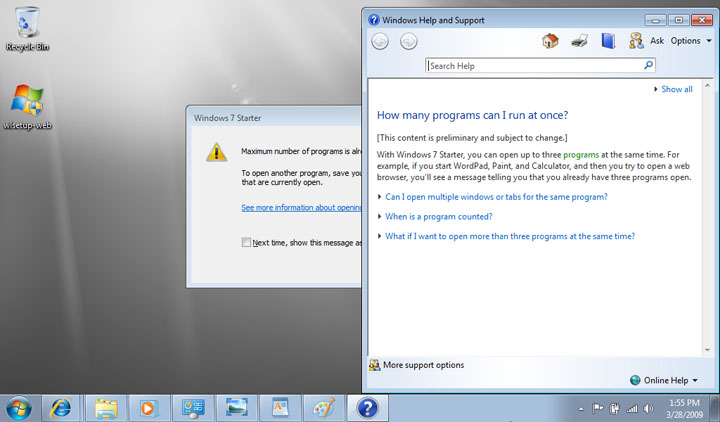Microsoft Makes $15 Per Windows XP Netbook
Reports today say that despite the fact that Microsoft’s Windows XP is near-defacto operating system on netbooks today, the Redmond company makes less than $15 per license sold.
Recent NPD data says that 96 percent of all netbooks sold throughout February 2009 came with Windows. Presuming that the vast majority of Windows-based netbooks run Windows XP rather than Vista, that means Linux is running on a mere 4 percent of netbooks. Microsoft is apparently trying to grab that last 4 percent.
The Wall Street Journal today cites people familiar with the matter as saying that Microsoft takes in less than $15 per netbook for Windows XP once marketing rebates are taken into account. This is compared to the $50 to $60 it receives for PCs running Vista. So why is Microsoft so eager to grab the entire market?
It’s a well known fact that Microsoft is planning to offer a stripped down version of Windows 7 developed specifically for netbooks. That said, while Windows 7 Starter is said to be “optimized” for netbooks, the widely reported fact that it can only run three applications at once is something many people have been wary of. If we fast forward to a time when an consumer is given the choice of running no more than three apps or using Linux, which would you choose? An XP user might not be a Windows 7 user, but a customer is a customer, right?
The WSJ cites Brad Brooks, corporate vice president for Windows product marketing at Microsoft, as saying Starter was created so that the company could offer Windows 7 on even the least expensive netbooks. Brooks maintains that despite its limitations, it is an easier and more stable OS than XP.
"When you see Starter on netbooks, there are a lot of impressions that it is limited," said Mr. Brooks told WSJ. "It's a pretty robust operating system for customers at the price points we're giving it to them," he finished.
Get Tom's Hardware's best news and in-depth reviews, straight to your inbox.

Jane McEntegart is a writer, editor, and marketing communications professional with 17 years of experience in the technology industry. She has written about a wide range of technology topics, including smartphones, tablets, and game consoles. Her articles have been published in Tom's Guide, Tom's Hardware, MobileSyrup, and Edge Up.
-
theuerkorn I think beyond technical reasons, most users are accustomed with Windows in one flavor or another. As most are not enthusiasts, but require for the equipment to simply work and know how to do things, it's a gamble for those to switch systems. The other system might be better, but being different requires new learning of things we already spent time on before.Reply
Just take OSX for an example. If you "grew up" on Windows you will be lost and at least initially unable to do simple things. You're basically programmed to expect it to be a certain way. I had a similar problem when going Amiga -> PC and I was simply bummed why I couldn't simply ... well I learned my ways around too.
Of course not to forget about available software and we might have invested in programs already. Switching systems also means new expenses for programs you already paid for (even if that ignores that most of those occasionally require upgrading too). -
A Stoner "It's a pretty robust operating system for customers at the price points we're giving it to them,"Reply
Offering would be a better way of saying this. But when you put into the context that this is written, I cannot help but think that the real thought behind the "we're giving it to them" is more closely aligned with the thought further up in the article about Microsoft taking that last 4% of market share. This leaves me with the feeling that the person making that statement is thinking "Since we are forced to sell at low price points, we are going to make sure we are the only game in town and force the customer to take what they deserve, which is a peice of shit operation system that is so pathetic that they will eventually be forced to fork over the total cost of their netbook just to get an operating system on it that is usefull, which of course will be the easy to upgrade Windows 7. Since we have pre-empted any companies from packaging their netbooks with any other operation system, people will be too scared to try anything other than what we are offering, cause they are all to stupid to figure it out on their own."
I think it is a brilliant strategy, let's see how it pans out for them. I for one went out and bought Windows XP professional x64, so now I have a 64 bit operating system that is not Vista or Windows 7. According to many reports, it will have support until 2015, which means I will be able to replace it with Windows World Domination Edition 11 or 12 depending on if I want to get the tested SP1 version or a raw untested version. -
Yoder54 slickuserthats about right. Their OS is worth only $19.99 IMOReply
Must must be talking about Argentina prices, where the rate of inflation is > 23%.
The real value would be about $9.99 USD. The Windows Experience...Priceless. -
A Stoner theuerkornI think beyond technical reasons, most users are accustomed with Windows in one flavor or another. As most are not enthusiasts, but require for the equipment to simply work and know how to do things, it's a gamble for those to switch systems. The other system might be better, but being different requires new learning of things we already spent time on before.Reply
The problem for Microsoft is that these people learned on Windows 95 or XP, and the new interface is no where near the same as those systems. This leaves opportunity where if someone were to want to break out of the Microsoft loop, this is the right time, because if you are going to relearn a whole new interface, and you have not been liking Microsoft, learn something that is new as well as not Microsoft. Microsoft is smart to work hard to prevent users from getting their hands on competitor's at this point in the software/hardware cycle. I am sticking with Microsoft, but I am sticking to the older XP iterations for now. -
WheelsOfConfusion Also, many companies just aren't offering models with Linux on them. I see a lot of people commenting on these stories saying "I bought it with XP, but first thing I did was put Ubuntu/SUSE on it!" And there have been complaints of the Linux versions available not being configured correctly, so sometimes hardware doesn't work out-of-the-box.Reply -
This is a link to an article at linuxdevices.com (Canonical disputes Microsoft netbook claims) which points out discrepancies with the 96% claim, although it acknowledge that the linux netbook market share is slipping.Reply
*http://www.linuxdevices.com/news/NS5701694759.html
"LeBlanc's claim that Microsoft Windows products, primarily Windows XP, run on 96 percent of netbooks might have been based on December 2008 through February 2009 numbers cited by the NPD Retail Tracking Service. While it does appear to be true that Windows XP has been gaining market share in recent months over Linux, the NPD numbers track in-store sales from brick-and-mortar retail stores, where Linux options are often not available, and do not appear to cover online sales. What's more, the NPD numbers only cover U.S. sales, where Windows predominates, while Linux is more popular in Europe and elsewhere.""If Le Blanc's 96 percent claim is true, it would represent a phenomenal turnaround for Windows. In November, Bloomberg.com reported that Linux gains in netbooks were hurting Microsoft's bottom line, and quoted Microsoft as estimating that Windows products run on about 70 percent of netbooks.""Despite the limitations of the NPD report, other anecdotal evidence, as well as a new study by Ovum, appears to suggest a slippage in Linux netbook market share. Ovum did not publicly report exact percentages, but reported that the Linux netbook share has dropped considerably in recent months. " -
JimmiG I would rather buy a netbook with XP than one with Win7 Starter and the 3-application limit. I regularly run 5-10 applications at once on my XP netbook and almost never less than 3.Reply -
thundercleese I have my wife's Dell Mini 9 (with 1GB, then later upgraded to 2GB RAM) running Windows 7 Beta with no problems. In fact, it runs better and faster than with the pre-installed XP. We've had Firefox open with 5+ tabs, OpenOffice.Org, Adobe Photoshop CS3, Winamp and 3 gadgets running at the same time with Aero on top of that. The stupid Intel Atom architecture can keep up, so why have a crippled version of Windows 7 out?Reply -
slickuser >> The real value would be about $9.99 USD. The Windows Experience...Priceless.Reply
I bet Windows experience is priceless .. also called hidden costs or Microsoft tax. Have fun with crappy Windows.
